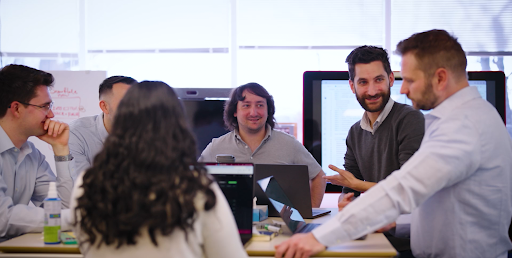
When I reflect on the Gen AI journey at a nearly 220-year-old company, I’m reminded that innovation rarely follows a straight path. Early experiments with these technologies, before ChatGPT transformed the landscape, produced mixed results. For example, initial attempts at using language models to generate product descriptions showed promising results at times, while others fell short of expectations. But this and other experiences taught one invaluable lesson: the employees that work closest to the day-to-day operations, often across departments and regions, are best positioned to identify where GenAI can deliver real enterprise value.
Taking a Calculated Risk
The launch of ChatGPT in late 2022 prompted many companies to make a strategic decision: limit GenAI access to a small group of technical specialists, or democratize it across their organizations. As we opted for the latter, we took a calculated risk, embracing the belief that AI should be a tool for everyone, not just a few. Company-wide access to Generative AI has enhanced productivity, sparked innovation and empowered people across all parts of the organization.
In support of this vision, we developed an internal AI platform called the AI Hub, aiming to provide secure, equitable access to AI capabilities for all employees, from frontline workers who manufacture our household products to scientists who help develop new products. These critical resources empower the workforce to utilize AI, democratizing access across the organization and fostering cultures of innovation and collaboration. More than just being another tool, this platform serves as a catalyst for transforming work, seamlessly embedding AI into the fabric of how we operate, solve problems and innovate.
As a result of this innovative approach, utilization of generative AI now spans multiple facets of our operations. One transformative idea that has changed the landscape is giving employees the ability to create their own AI assistant. These custom chatbots can be built in minutes and are tailored to specific job functions.
Measuring Success and Impact
Employee response has exceeded expectations. Empowered with the technology, employee teams have developed thousands of AI Assistants that are delivering real time impact. What strikes me the most is the diversity of innovation fostered: manufacturing teams created tools for real-time technical translation, marketing teams enhanced their creative processes and HR streamlined access to knowledge. The most impactful solutions often emerged from unexpected areas of the business.
To date, my organization has approximately 14,000 unique users, equivalent to about 90% of our desk worker population, engaged with the platform. Employees report saving three to four hours per week and, importantly, two out of three AI conversations are reported to increase quality of work. Further, 80% of chats are rated as leading to more creative outcomes.
My experience with employee grassroots innovation at a multinational CPG company has reinforced the importance of close collaboration with IT developers and our central AI team to focus on enterprise-wide strategic priorities. This dual approach allows us to harness creativity from across the organization while driving strategic objectives like marketing engagement, innovation and operational efficiency. The AI team also plays a critical role in governance, scalability and ensuring that use aligns with our organization’s Responsible AI Principles. We want to prioritize the biggest ideas with the greatest potential to drive business impact and advance our purpose: reimagining a healthier future for all.
Embedding measurement capabilities directly into employee AI platforms has enabled teams to track tangible outcomes, like time saved, quality improvements and creativity gains. When employees see concrete metrics demonstrating the impact of their AI assistants, it fuels momentum for further adoption and innovation. It turns AI from a concept into a measurable contributor and business growth driver.
Implementing Change Management and Responsible Innovation
Investing time into new technologies across the leadership structure in any organization is key to adoption. When leaders implement comprehensive training programs globally and ensure employees at all levels can effectively leverage AI tools, they will foster a culture of continuous learning and innovation.
Our strategic embrace of generative AI is unlocking opportunities across departments, ensuring that its potential is leveraged across my company from operational efficiencies to customer engagement. This progress is underpinned by a robust governance framework that balances innovation with risk management. Close collaboration between our AI, IT, Ethics & Compliance and Legal teams have proven to be key in establishing clear guidelines while maintaining the flexibility to adapt quickly to new opportunities.
Looking ahead, we are exploring the potential of AI agents, autonomous systems capable of managing complex workflows, while maintaining the same fundamental approach. This approach empowers those who are closest to the work to be able to design and implement solutions on their own. By prioritizing employees and equipping them with the tools, training and autonomy to identify opportunities, we enable them to experiment with AI and drive innovation that meets their unique needs.
Enabling a Human-Centered Approach to AI Transformation
This human-centered approach ensures that AI is not a top-down directive, but a collaborative enabler that amplifies the creativity, expertise and problem-solving power of our workforce at an almost 220-year-old company. As we move into this next phase of AI maturity, we must remain committed to responsible innovation, guided by our values and focused on delivering meaningful outcomes for the people and markets we serve.
Success comes from combining strategic direction with distributed innovation. When you provide teams with the right tools, training and trust, they’ll identify opportunities that centralized planning might miss.
AI has evolved from an experimental technology to an integral part of how organizations operate. By maintaining this balance between enterprise strategy and employee-driven innovation, leaders will continue to discover new ways to create business value at scale and advance organizational agility, resilience, and long-term growth.





